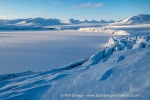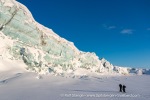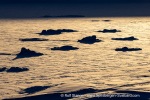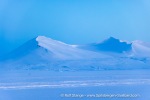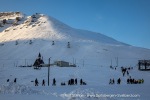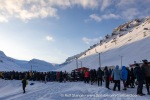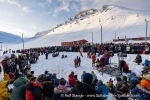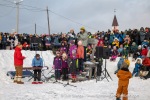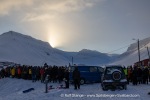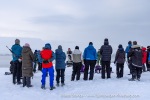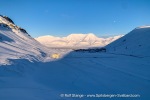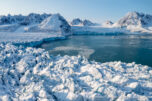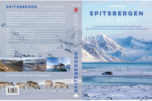-
current
recommendations- Liefdefjord
New page dedicated to one of Spitsbergen's most beautiful fjords. Background information and many photos.
- New Spitsbergen guidebook
The new edition of my Spitsbergen guidebook is out and available now!
- Liefdefjord
New page dedicated to one of Spitsbergen's most beautiful fjords. Background information and many photos.
Page Structure
-
Spitsbergen-News
- Select Month
- April 2025
- March 2025
- February 2025
- January 2025
- December 2024
- November 2024
- October 2024
- September 2024
- August 2024
- July 2024
- June 2024
- May 2024
- April 2024
- March 2024
- February 2024
- January 2024
- December 2023
- November 2023
- October 2023
- September 2023
- August 2023
- July 2023
- June 2023
- May 2023
- April 2023
- March 2023
- February 2023
- January 2023
- December 2022
- November 2022
- October 2022
- September 2022
- August 2022
- July 2022
- June 2022
- May 2022
- April 2022
- March 2022
- February 2022
- January 2022
- December 2021
- November 2021
- October 2021
- September 2021
- August 2021
- July 2021
- June 2021
- May 2021
- April 2021
- March 2021
- February 2021
- January 2021
- December 2020
- November 2020
- October 2020
- September 2020
- August 2020
- July 2020
- June 2020
- May 2020
- April 2020
- March 2020
- February 2020
- January 2020
- December 2019
- November 2019
- October 2019
- September 2019
- August 2019
- July 2019
- June 2019
- May 2019
- April 2019
- March 2019
- February 2019
- January 2019
- December 2018
- November 2018
- October 2018
- September 2018
- August 2018
- July 2018
- June 2018
- May 2018
- April 2018
- March 2018
- February 2018
- January 2018
- December 2017
- November 2017
- October 2017
- September 2017
- August 2017
- July 2017
- June 2017
- May 2017
- April 2017
- March 2017
- February 2017
- January 2017
- December 2016
- November 2016
- October 2016
- September 2016
- August 2016
- July 2016
- June 2016
- May 2016
- April 2016
- March 2016
- February 2016
- January 2016
- December 2015
- November 2015
- October 2015
- September 2015
- August 2015
- July 2015
- June 2015
- May 2015
- April 2015
- March 2015
- February 2015
- January 2015
- December 2014
- November 2014
- October 2014
- September 2014
- August 2014
- July 2014
- June 2014
- May 2014
- April 2014
- March 2014
- February 2014
- January 2014
- December 2013
- November 2013
- October 2013
- September 2013
- August 2013
- July 2013
- June 2013
- May 2013
- April 2013
- March 2013
- February 2013
- January 2013
- December 2012
- November 2012
- October 2012
- September 2012
- August 2012
- July 2012
- June 2012
- May 2012
- April 2012
- March 2012
- February 2012
- January 2012
- December 2011
- November 2011
- October 2011
- September 2011
- August 2011
- May 2011
- April 2011
- March 2011
- February 2011
- January 2011
- December 2010
- November 2010
- September 2010
- August 2010
- July 2010
- June 2010
- May 2010
- April 2010
- March 2010
- February 2010
- November 2009
- October 2009
- August 2009
- July 2009
- June 2009
- May 2009
- April 2009
- March 2009
- February 2009
- January 2009
- December 2008
- November 2008
- October 2008
- August 2008
- July 2008
- June 2008
- May 2008
- April 2008
- March 2008
- February 2008
- April 2000
- Select Month
-
weather information

| Guidebook: Spitsbergen-Svalbard |
Home → March, 2025
Monthly Archives: March 2025 − News & Stories
Mine 7 to be closed in July. Or not?
Coal is still mined at Mine 7 in Adventdalen, near Longyearbyen. Mine 7 is the last Norwegian coal mine in Svalbard still in operation.
But not for much longer: the mine is due to close this summer, with production due to cease towards the end of June.
Many in Longyearbyen are not happy about this, and whatever one’s views on coal mining in general, there is no doubt that the loss of several dozen well-paid industrial jobs is significant for a town of around 2500 inhabitants. Various suppliers are also expecting a loss of business.
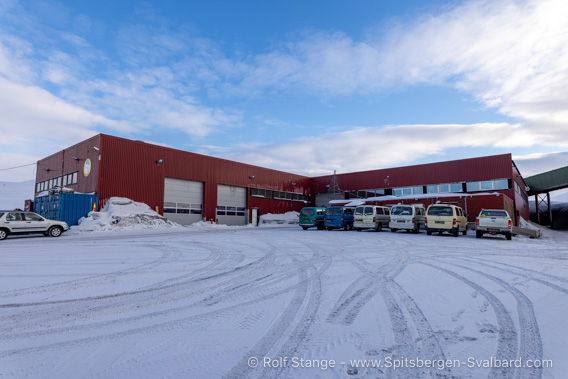
Surface installations of mine 7.
The “news” has now reached the political arena in Oslo. Even Emilie Enger Mehl, who as Minister of Justice and and such responsible for Norway’s Svalbard policy played a decisive role in the decision to close Mine 7, has now spoken out accordingly, according to Svalbardposten. The only problem is that Mehl is no longer a minister. The loss of office obviously led to a change of opinion in Mehl’s case.
The end of mine 7 is not just a political issue, however: the coal reserves will soon be exhausted and the mine would not be able to operate for much longer. If Norway wants to continue coal mining in Svalbard, a completely new mine would have to be developed, which would also mean extending the road into so far untouched areas. Years ago, coal deposits were explored on the mountain Bassen on the north side of Adventdalen (Bassen is part of Operafjellet) with the idea of developing “Mine 8” there.
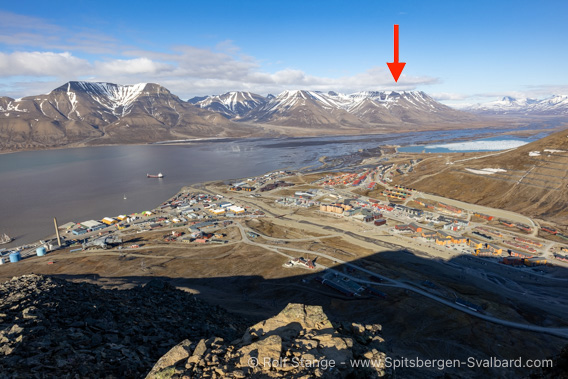
The mountain Bassen in Operafjellet was once intended to become “Mine 8”.
However, this never materialised and it seems politically unlikely that it will ever happen. And so Norwegian coal mining in Spitsbergen will probably be history by the end of this summer.
Weather

A windy ride Saturday afternoon in Adventdalen.
Weather is always good, you always have some. Longyearbyen often has a lot of it, and the last few days have been no exception. During the night from Thursday to Friday, there was a severe storm over parts of Spitsbergen, which caused considerable damage to the temporary facilities in the field.
On Saturday evening, the flight from Oslo to Longyearbyen was cancelled, and the night was so stormy that it was difficult or impossible to get from A to B, even within the town. Avalanche-exposed areas were closed by the Sysselmester.
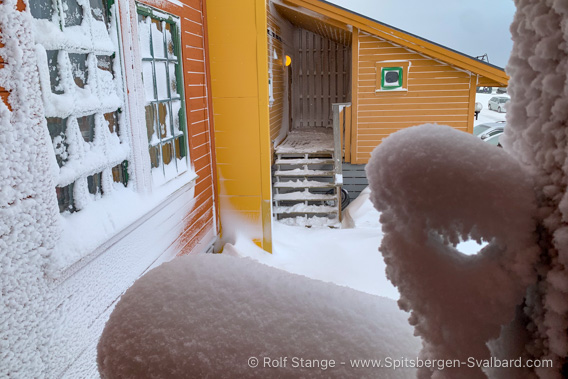
Sunday morning in Longyearbyen.
Under such conditions it is better to work on new editions of books and other projects. There are currently visible results in the ‘This page should be more beautiful’ section: Several pages have been enhanced with maps, photo galleries and possibly text. It’s worth taking a virtual look at the plane wreck at Kapp Borthen (the plane from the war), Svenskhuset at Kapp Thordsen (the ‘ghost house’) or the old trapper’s hut on Lågøya. Enjoy!
A trip to Mohnbukta
Tue
18 Mar
2025
In this glorious weather we just had to go, and one area we always like to visit is the east coast of Spitsbergen, here Mohnbukta. Crisp -20 degrees, blue sky, blue-green ice … marvellous!
- gallery anchor link: #gallery_3539
Click on thumbnail to open an enlarged version of the specific photo.
One more reason for a tour is, of course, when you have a nice visitor. In this case, we were joined by Serge, who I’m sure some of you will remember fondly as the captain of SV Antigua in recent years. I am all the more pleased that Serge will remain with us even without Antigua: as captain, he will also accompany several of our trips on SV Meander in summer 2025! 😃👍
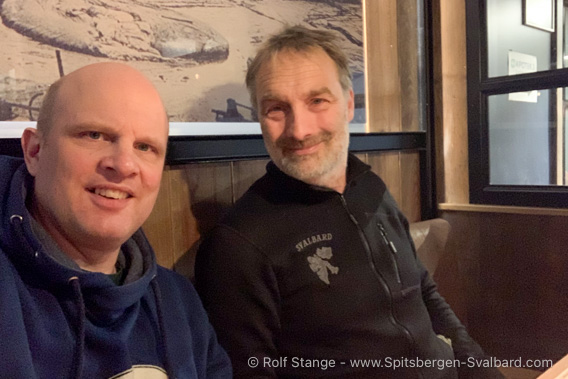
Serge (right) and Rolf are looking forward to eating in Longyearbyen 😋
After 10 hours at -20 degrees, you don’t look quite as crisp as usual … 😵💫
New pages
As always I love to work on this website, making new pages or making old ones better. Today I have got three new ones:
The ‘old hospital staircase’ in Longyearbyen. Not far away, but an integral part of Longyearbyen’s annual cultural calendar.
Far away and difficult to reach are Depotodden with the Oxford House in Brennevinsfjord and the small Jäderinfjord in Lady Franklinfjord, both on Nordaustland.
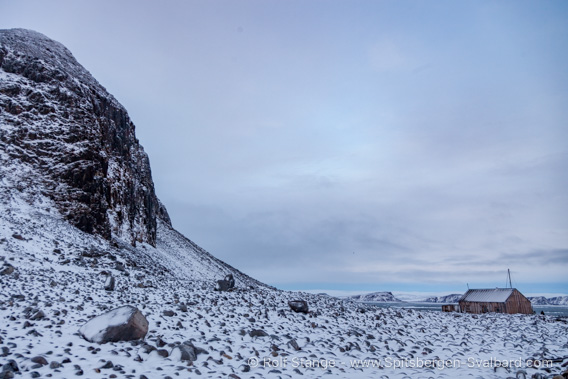
The Oxford House at Depotodden in Brennevinsfjord has a beautiful page of its own.
All three sites are worth a little digital visit – have fun and enjoy the weekend!
Sun celebrations
A week in Longyearbyen, part 1: The sun festival
It’s already been a week. On the 8th of March, people gather at the stairs of the old hospital, close to Svalbard church, as the first rays of sunlight reach Longyearbyen – for the first time since the beginning of October! Of course there are proper celebrations. A bit more about that and more pictures can also be found on the new page about the location of the event, the old hospital staircase.
- gallery anchor link: #gallery_3536
Click on thumbnail to open an enlarged version of the specific photo.
Dangerous encounter with a polar bear at Fredheim
Last Monday (24 February) there was an encounter between a polar bear and a group of tourists near Fredheim in Tempelfjord. Details have now emerged in an article in Svalbardposten, making it clear that the incident was dramatic and that it was only by luck that no one was injured and the polar bear was not.
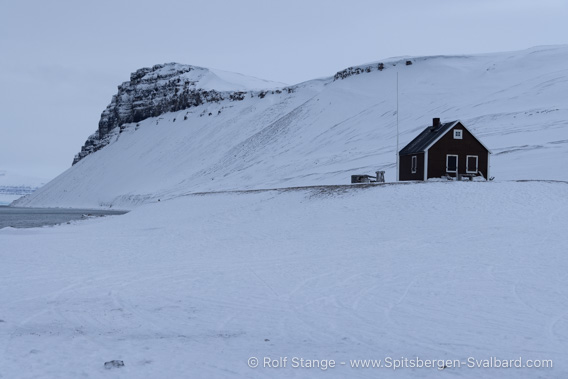
Fredheim two days after the dangerous encounter.
The group had been on a day trip by snowmobile from Longyearbyen and had reached Fredheim and were preparing to stop for a meal. According to one of the French tourists involved, the polar bear suddenly appeared within two or three metres of the group.
The details of what happened next are not public knowledge, but according to witnesses, one woman fell as she ran away, and shortly afterwards the bear had reached her and was standing with one paw on her back. However, it is said that the bear was not aggressive and did not try to attack the woman or anyone else. According to Svalbardposten, Frenchman Antoine Terrones described the polar bear’s behaviour as follows: “I did not perceive it as an attack, it was not as if the bear was hungry and determined. It seemed relaxed, raised its head as if it was sniffing, and walked slowly towards us.”
But then the bear picked up speed and started following the woman, who was soon on the ground with a bear’s paw on her back.
At this point, the guides fired with signal pistols and rifles to scare the bear away, which was successful. One guide was said to have been ready with a rifle to shoot the bear, but before that point came, the animal was driven away by a shot from a signal pistol. The bear then moved away from the group as more shots were fired.
There was another group of tourists nearby and their guides had prepared with signal pistols and rifles.
The whole incident happened in a matter of moments.
As soon as the immediate danger had passed, the group returned to Longyearbyen and informed the Sysselmester. All those directly involved then met with a crisis team to deal with the shock. According to eyewitness Terrones, some of the people involved were quite affected by what had happened, and the discussions with the crisis team were very helpful in dealing with the situation.

Fredheim with polar bear (the photo was taken years ago).
The use of a crisis team after a polar bear encounter where there were no injuries or worse to humans or animals is unusual and already suggested that the incident was dramatic.
Unfortunately, not enough is known about the exact course of events to really understand what happened and how the polar bear was able to get so close to the group unnoticed. According to eyewitnesses, one of the guides had gone out to check the area for polar bears. In general, the behaviour of everyone involved in the incident was praised and described as impeccable, according to others who have received first-hand reports just minutes before the incident. Svalbardposten quotes Frenchman Terrones as saying: “When the bear came, the guides reacted quickly and correctly. I think they saved our lives. I have nothing negative to say about their reaction. They did everything they could in a difficult situation.”
The bear can actually be seen in a photograph taken before it appeared, although it was not discovered until later. When the photo was taken, the bear was on the shore of Tempelfjord, about two or three kilometres northeast of Fredheim.
Commentary
So much for the information actually known in public. Beyond that, it would be interesting to know exactly how many people were there in total, how many guides were there and, most importantly, where exactly the people involved were at the time in question. To be clear, this is not about pointing fingers, it is about trying to understand how a polar bear could get within a few metres of a group of people unnoticed. But without really accurate information, we can only speculate.
Speculation is never good, but not thinking at all is even worse. So here is a bit of speculation.
We know that the bear was on the shore north-east of Fredheim before the incident. We also know that the group in question were preparing their lunch at the Fredheim huts when the bear suddenly appeared next to them.
The Fredheim huts are situated on a terrace a few metres higher than the nearby shore. The slope leading down from the terrace to the shore can only be seen if you are standing close to it; if you stand a little further away, there is a blind spot. It is reasonable to assume that the bear was walking in this area when it approached unnoticed. This is also an obvious assumption as this is exactly the route along the shore that bears often take.
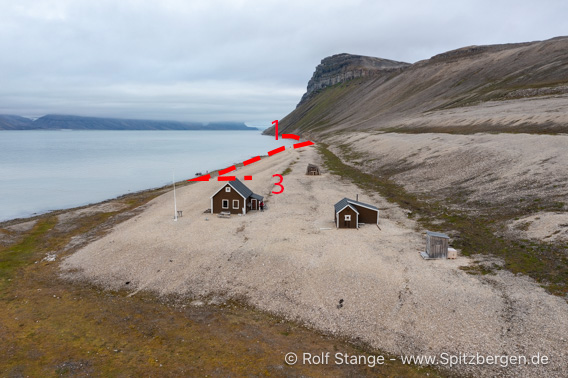
Overview picture of Fredheim and surrounding area with possible positions to illustrate the assumed sequence of events. The bear was approximately at position 1 when it was photographed but not seen (it was only discovered later in the photo). If the bear was following approximately the dotted route, this could explain why it was not seen when – if – the group was at position 3. All positions are assumed, especially position 3 is only assumed based on the existing description and knowledge of the terrain and the usual (but not the concrete) procedures on site.
Assuming that this was the case (which is not a certainty), the important takeaway would be to bear in mind that safety always depends on the areas of terrain that you can not see. It is not enough that there are no bears where you can see them if they were there. The question is what is there where the terrain obscures the view.
Constant vigilance and ‘what-if’ thinking, especially in relation to areas of terrain that cannot be seen, are and will remain key aspects of staying as safe as possible in polar bear country.
The fact that the polar bear was visible in a photograph taken prior to the incident, but was not recognised, is a point that may give pause to those involved.
These points should be taken into consideration, especially if you are one of those responsible for others in the Arctic. But not only that, because it is always the attention of all those present that can, should and must contribute to avoiding dangerous situations.
One final comment: If it were the case – and this is the impression given by the descriptions available – that a woman was lying on the ground, the polar bear was standing right next to her or even more or less on top of her, and a guide was standing a few metres away with a rifle, ready to shoot to kill, but did not do so, for example in order not to endanger people in the confused situation with shots and/or to protect the polar bear, as long as shooting was not absolutely necessary: hats off, you have to have the nerves to act like that!
Longyearbyen’s drinking water: legionella and manganese
For decades, most consumers in Longyearbyen have probably not given much thought to their drinking water. After all, it is drinking water from the surrounding arctic nature, so surely it should be clean? Even after intermediate storage in the artificial lake Isdammen in Adventdalen or – depending on the season – in a drinking water reservoir on the outskirts of Gruvedalen. Of course, there is also filtering and monitoring.
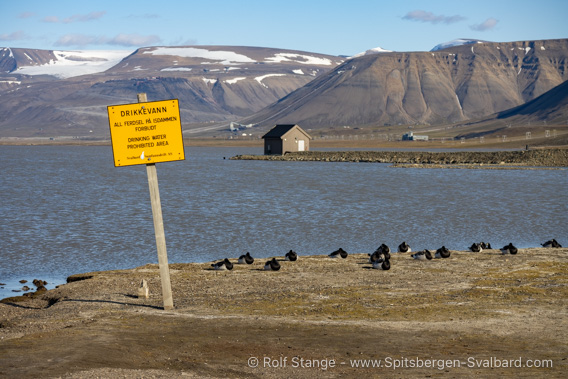
The drinking water lake ‘Isdammen’ in Adventdalen.
But the carefree tranquillity around drinking water has been over for a few months now: Legionella bacteria have been detected in drinking water samples from Longyearbyen. This is initially no reason to panic, as tap water that is completely free of legionella is rather rare worldwide. It depends on the exact type of germ and its number. Many Legionella types are harmless to humans, and bacterial counts below the permitted limits are almost always present, especially in older pipe networks such as in Longyearbyen.
However, due to the rather dribbling communication strategy of the local authority (Longyearbyen Lokalstyre), the issue did become, well, an issue. It was a bit like ‘we have legionella in our drinking water, but don’t worry, everything is fine’. More precise details on the type and bacterial count were not made public; according to official information, the water was (and is, with one caveat, see below) still drinkable and safe for human health.
At the end of February, Lokalstyre organised a residents’ meeting to provide information on the current situation regarding drinking water (legionella and manganese, see below), and there are now a number of announcements and press releases on the Lokalstyre website as well as articles and letters to the editor in the Svalbardposten.
No health problems due to Legionella are said to have occurred so far. These could occur primarily by inhaling germ-contaminated very small water droplets (aerosole) in the air, for example when showering. A potential risk is said to exist above all for risk groups such as older or immunocompromised people.
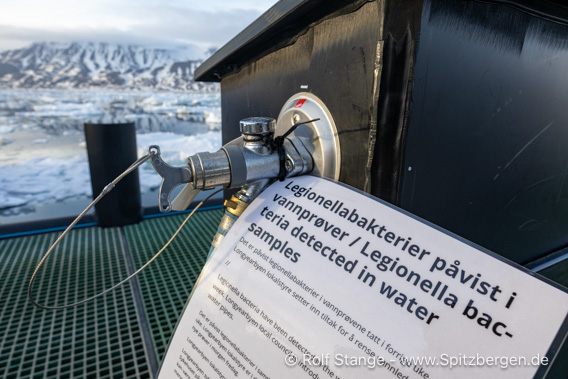
Legionella notice at the drinking water tap in Longyearbyen harbour.
A source for the germ could not be localised; it is likely that large parts of the old pipe network and the biofilms contained therein are the diffuse source. The levels (bacterial counts) were temporarily reduced by adding chlorine and the pipes were flushed several times in sections, but neither is a definitive solution, at least not in the sense that Legionella will disappear in the long term. At times, consumers were advised to take precautionary measures, such as showering without a shower head to avoid atomising the water into fine droplets that could be inhaled. Svalbardhallen (swimming and sports hall) was also closed at times. All in all, there was quite a lot of fuss about a problem that was actually harmless according to official information, which led to a certain amount of concern in town.
It will probably come down to the fact that chlorine will have to be added to the drinking water again and again in the long term in order to keep the bacterial load within acceptable limits. The side effect is that the drinking water tastes of chlorine, just like in a swimming pool. It looks like you have to get used to it. There are also small, household water filters based on activated carbon that help the water regain its fresh flavour. Others have been buying bottled water from the Svalbardbutikken supermarket for some time. The large (five litre) bottles are now rationed there: only three bottles are sold per household per day so that there is enough for everyone.
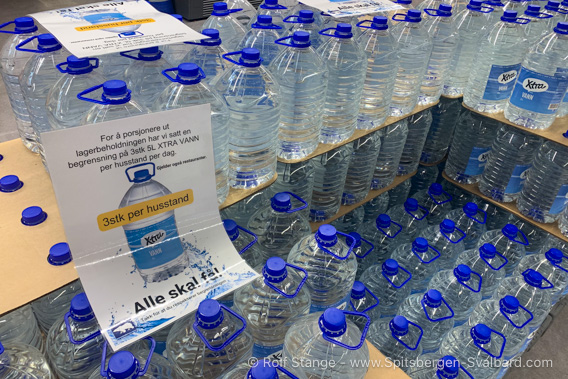
Water bottles in Svalbardbutikken.
But there is another problem: manganese, a metal (chemically more precise: transition metal) that occurs frequently in nature, including in the sedimentary rocks around Longyearbyen. Manganese is also present in pretty much every sip of drinking water worldwide, but as always, the quantity is the point.
The Norwegian Health Authority (FHI, Folkehelseinstitutt), which was consulted, has now concluded that the manganese levels in the drinking water have been too high since September 2024 to supply infants (0-12 months) with it. Affected families can get free bottled water at Svalbardbutikken. For everyone else, however, there should be no health risk associated with the consumption of tap water; health-relevant exposure should only occur at higher concentrations over longer periods of time (10 years and more). Acute poisoning is only theoretically possible at extremely high concentrations.
This is the official position. For adults (everybody older than 12 months 😄), the following therefore still applies: raise your glasses and cheers, it just sometimes doesn’t taste quite fresh, but it doesn’t matter.
I would like to expressly point out that I am not an expert on drinking water and Legionella and manganese in it; I am summarising official reports to the best of my knowledge, but not my own assessment or opinion.
News-Listing live generated at 2025/April/04 at 12:50:08 Uhr (GMT+1)
